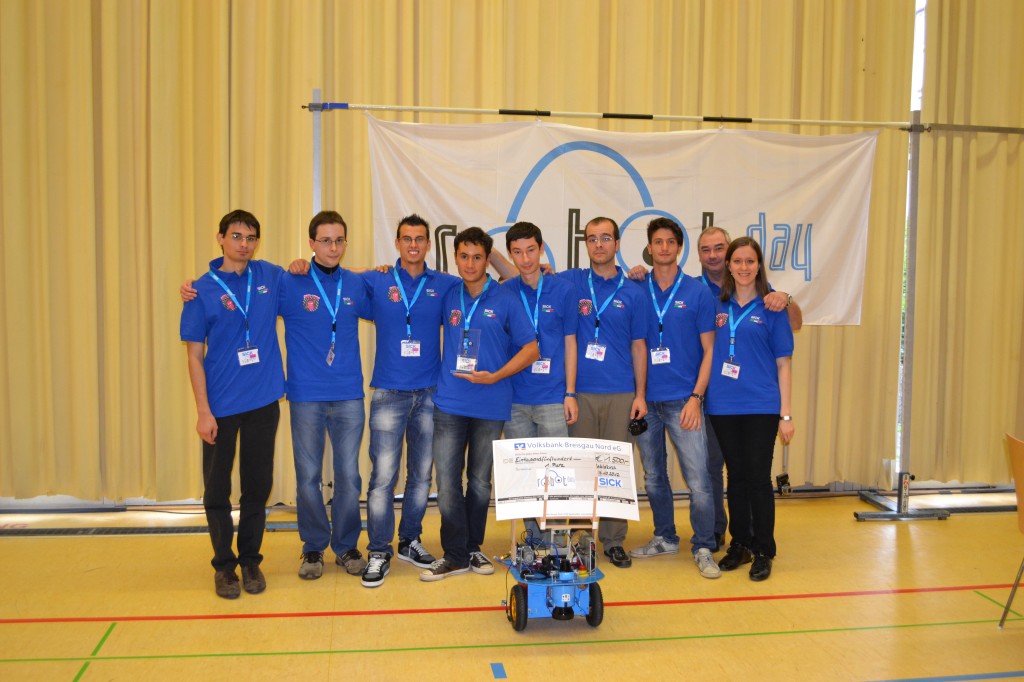SICK Robot Day 2012.
International competition for mobile robot. The challenge, organized by SICK AG, will be some kind of orienteering race. The course is a convex arena about 25 x 25 meters, which contains 27x3 balls of three different colors. At each round three robots must detect, pick and bring the ball with the assigned color to correct pen. The robots must avoid collision with other robots and the border of the arena. For other information see Robot Day general rule. The event took place on Saturday, October 6, 2012 in the Stadthalle in Waldkirch (Germany). Team ReadBeard Button from the University of Parma won the competition bringing 7 balls in first 10 minutes round.Robot Hardware
The robot is a MobileRobots Pioneer 3DX equipped with Sick LMS100 and TiM300 range finders placed at two
different heights, a Logitech C270 camera and a forklift for taking, carrying
and dropping balls. Several alternative solutions have been considered for ball
transportation.
The forklift has the advantages of avoiding sensor occlusions and of caging the
ball during the navigation, although approaching, raising and dropping of the
target require careful software management.
Control Architecture
The control architecture consists of independent modules, each devoted to a
specific task. During development and testing, components have been added,
removed or linked differently to reach the proper final configuration. The
ball detection components merge laser scanner and camera data to estimate ball
position and color. Target tracking is provided to address intermittent
observations and failures of detection algorithm. The localization and mapping
modules detect the pen location from laser sensor and use this information to
estimate and correct robot pose.
Since the ball positions are ephemeral and may change during the race, the pens
and the border of arena represent the only stable landmarks that can be
exploited to localize the robot. The navigation component is responsible for
the robot behavior in the different situations. It primarily guarantees motion
safety by avoiding collision with other robots, obstacles and balls.
Furthermore, it handles the different phases of the competition: the random
exploration of free space, the approach and detection of the target balls, the
navigation to the pen, and the dropping of the ball.
Discussion
The effectiveness of the developed robotic system has been proved by the 7
green balls picked and brought to the pen in the first round of Sick Robot Day.
The robot has approached and caged only the green balls, also when balls of
another color were in contact with the target balls. Furthermore, the robot
has successfully reached the pen by exploiting the localization system.
The main pitfall has been apparent in the second round, when the robot wasn't able
to successfully detect the white balls due to reflections and
difficulties in the segmentation of such color. The lack of sensor data in
ball dropping phase is the second limitation, which resulted in collision with
the border and penalties. When the forklift is lowered, the laser scanner is
partially occluded preventing the obstacle detection. A closer integration of
sensor data could improve and overcome these problems.
Nonetheless, the experience is positive since the team has successfully
addressed several design and development problems and has learned to
iteratively improve the system from the experimental results.
Reference
- M. Cigolini, A. Costalunga, F. Parisi, M. Patander, I. Salsi, A. Signifredi, D. Valeriani, D. Lodi Rizzini, S. Caselli, Lessons Learned in a Ball Fetch-And-Carry Robotic Competition, Journal of Automation, Mobile Robotics and Intelligent Systems (JAMRIS), Issue 01, Vol. 8, p. 82-90, 2014. [pdf]
- Sick Robot Day Official Page
- Robotika
Read Beard Button team, winner of Sick Robot Day 2012!

